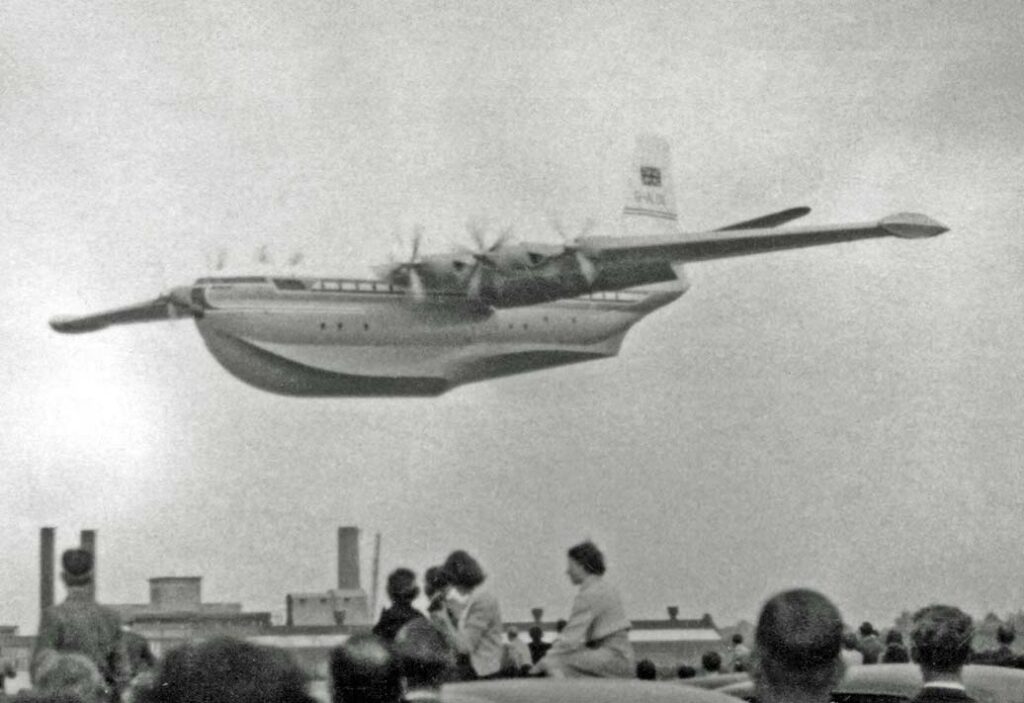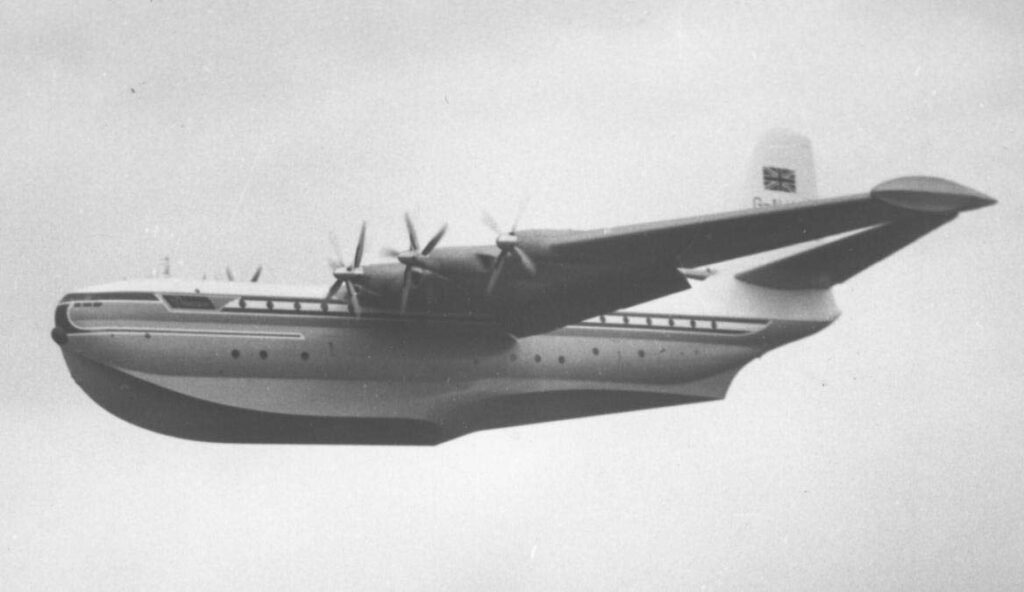The SR.45 Princess was a large British flying boat, designed for long-range, transatlantic flights with luxurious accommodations.
In brief
The Saunders-Roe SR.45 Princess was one of the largest metal flying boats ever constructed, designed during the late 1940s as a luxury airliner for transatlantic routes. With its sleek, aerodynamic design and impressive size, it embodied the pinnacle of flying boat technology. The Princess featured ten Bristol Proteus turboprop engines, a pressurized cabin, and could accommodate up to 100 passengers. Despite its advanced design and capabilities, the emergence of long-range land aircraft and changing market dynamics led to the project’s cancellation after only three prototypes were built, with none entering commercial service.
In the immediate post-World War II era, there was significant interest in expanding commercial air travel, particularly on long-range routes such as the North Atlantic. The Saunders-Roe SR.45 Princess was conceived in this context, aiming to combine the romance of sea travel with the speed and efficiency of air transport.

History of the Development of the Saunders-Roe SR.45 (Princess)
After World War II, Britain sought to reclaim its preeminent position in global aviation. At the time, flying boats had several advantages for long-distance travel, including the ability to land on water, which was seen as making them viable for routes where airports were scarce. The Saunders-Roe company, known for its expertise in marine aircraft, was tasked with developing a large, luxurious flying boat. The SR.45, later named the Princess, was envisioned as a flagship airliner that would outclass its competitors in speed, range, and passenger comfort.
The program was launched in the late 1940s, with a vision of air travel transitioning to luxurious flying boats. The Princess first flew on 22 August 1952. However, by the time of its development, land-based aircraft technology had advanced significantly, and the economic viability of such large and complex flying boats was in question. The project did not receive a NATO nickname, as it was primarily a commercial rather than military endeavor.
Design of the Saunders-Roe SR.45 (Princess)
The Saunders-Roe Princess was a marvel of engineering, featuring a sleek hull, high-mounted wings, and a gull wing tailplane. It was approximately 148 feet in length with a wingspan of 219 feet, making it one of the largest aircraft of its time. The all-metal hull incorporated advanced aerodynamics and hydrodynamics for efficient flight and water operations.
The aircraft was powered by ten Bristol Proteus turboprop engines, mounted on the wing in pairs, driving contra-rotating propellers. This arrangement provided the power necessary for the large, heavy aircraft to achieve adequate performance. The pressurized cabin offered unprecedented comfort and space, akin to a luxury ocean liner.
However, the complexity and maintenance requirements of the Princess, along with its reliance on extensive infrastructure for water landings, were significant drawbacks. Additionally, the rapid development of long-range land planes and shrinking market interest in flying boats posed challenges to the viability of the design.
Performance of the Saunders-Roe SR.45 (Princess)
The SR.45 Princess was designed to achieve a top speed of around 380 mph, with a range of approximately 5,300 miles, making it suitable for transatlantic flights. Its performance was competitive with other long-range aircraft of the era, but its operational costs, complexity, and the infrastructural requirements for water landings limited its practicality and appeal.
Variants of the Saunders-Roe SR.45 (Princess)
The Saunders-Roe Princess program produced three prototypes, with each intended to test various aspects of the design and performance. However, the project did not advance beyond these prototypes due to changing market conditions and the shift towards land-based aircraft for long-range travel. As a result, no operational variants or production models were developed beyond the initial prototypes.

Military use and combat of the Saunders-Roe SR.45 (Princess)
The SR.45 Princess was not used in military service or combat. It was designed as a civilian airliner and did not have armaments or military adaptations. The changing landscape of aviation and the shift in focus to more efficient land-based aircraft led to the project’s cancellation before any of the prototypes could be used in commercial service or adapted for military use.
The Saunders-Roe SR.45 Princess represents a high point in the era of large flying boats, reflecting the ambition and technological prowess of post-war Britain. Despite its impressive design and capabilities, the Princess was a victim of changing times, as advances in land-based aircraft made flying boats obsolete for long-range travel. While it never fulfilled its intended role as a luxurious transatlantic airliner, the Princess remains a symbol of the bold ambitions of aviation in the mid-20th century and serves as a reminder of the ephemeral nature of technological advancement. Its legacy continues to inspire innovation and the pursuit of daring solutions in aerospace design.
Back to the Seaplanes section.